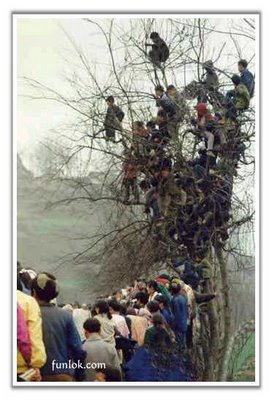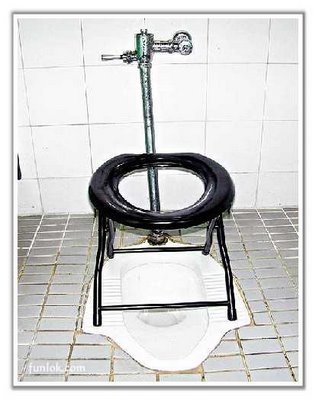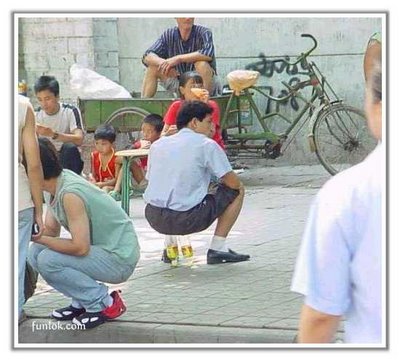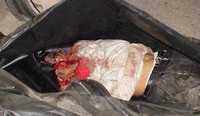Peace Talks On North East Is Without Peace
Palash Biswas
(c/o Mrs Arti Roy, Gostokanan, Sodepur, Kolkata-700110, India.
Phone:033-25659551 R)
North East insurgency problem is taking a serious turn.It is said
thatTop leaders of five underground groups active in the northeastern
states of Assam, Manipur, Tripura and Meghalaya are engaged in either
formal or informal talks with the government of India. But peace
seems far away.Lack of mass support, large scale illegal migration
from Bangladesh and foreign support to insurgency have made the
situation worst and any initiative does not get proper milage.Ulfa
demands sovereignity while MSCN emphasises on greater Nagaland.
Indian authorities and leaders of a front line tribal separatist
group were involved in peace talks in
Amsterdamrecently, aimed at ending more than 56-years of violent
insurgency
in northeast. The northeastern region of India covering a total area
of about 2,55,000 sq km is surrounded by Bangladesh, Bhutan, China
and Myanmar. Less than one percent of the external boundaries of the
region are contiguous with rest of India while remaining 99 percent
form international borders. There is not only geographical isolation
of this region but also absence of cultural and psychological
integration with the mainstream. Many ethnic groups in the region
especially in the areas bordering the international boundaries have
more in common with the population living across the boundary than
with the rest of India. Bangladesh has been active in exploiting the
situation in the Northeastern region and this has had impact on the
overall security in the region.
The NSCN, fighting for an independent homeland for the Naga tribes
in Nagaland, is the oldest and the most powerful of the nearly 30-odd
rebel armies operating in the region. "We are pinning great hopes on
the talks although we know we cannot expect a solution overnight," a
senior NSCN leader told IRNA
by telephone from Dimapur, Nagaland`s commercial hub.
The NSCN is likely to raise its demand for integrating all Naga
tribal inhabited areas in the northeast during the Amsterdam talks,
dubbed as `very crucial` by both the sides.
The NSCN is stressing on the need for creation of a Greater
Nagaland by carving slices off the neighbouring states of Arunachal
Pradesh, Assam, and Manipur -- all of which have sizeable Naga
populations. "Without the unification of the Naga homeland (Greater
Nagaland),
there can be no permanent solution," the NSCN leader said.
The demand for a Greater Nagaland is, however, not acceptable to
the other regional states in the northeast. "There would be more
turmoil than peace in the region if New Delhi tries to appease the
NSCN by agreeing for a Greater Nagaland," Manipur Chief Minister
Okram Ibobi Singh said. But amid the controversies, NSCN leaders are
hopeful for a
settlement.
The Supreme Court has rather belatedly ordered the appointment of a
three-man local commission to identify the boundaries of Assam,
Arunachal Pradesh and Nagaland as unquiet borders have often been the
cause of tension and death. As early as in 2001 former attorney-
general Soli Sorabjee had talked of such a commission and suggested
that its recommendations be made binding on the states concerned.
Manipur is undoubtedly the only State in India besieged by nearly 30
militant organizations. The power of the State administration does
not run beyond a few kilometers from the capital. The situation in
Manipur has become one of the most serious threats to national
security today.
Over 58 years of Indian Independence, nobody in India realized that
the country's integrity was so threatened until a dozen Manipuri
women shed their clothes in front of an Army garrison in the heart of
the Imphal and taunted the soldiers to rape them. Only then the
nation woke up and asked itself what was wrong in Manipur and why
these otherwise conservative Manipuri ladies had taken such a
desperate and extreme step.
Greater Nagaland agitation is opposed most violently in
Manipur.Although the media pays considerable attention to the Army's
role in tackling militancy in the State, the Government of India's
casual handling of the situation created a flutter. The revelation
made by Union Defense Minister, Pranab Mukherji, during his recent
visit to a Leimakhong Army base, near Imphal, that the Center had
already signed ceasefire agreements with eight militant
organizations, mostly Kuki militant outfits, in Manipur, has clearly
proved that it wants to play safe while the State remains in a
chaotic condition. State Chief Minister, O Ibobi Singh has denied
that truce arrangements, which became effective on 1st August, 2005,
were done with his knowledge. This shows that the State was in the
dark for nearly two months about these covert truce deals with the
militant groups.
Despite declaring fresh dates for cease fire the government of India
failed to start the much waited peace talks with ULFA at all as it is
emphasising on the precondition for peacetalks demanding written
letter from the outfit to ensure compliance after the talks conclude.
The ULFA leaders are not released. At this point a tea garden manager
is killed and fresh letters to tea gardens are issued by Ulfa to tea
gardens demanding large amounts. The centre has given green signal to
the army to launch operation. At this point of time,the Ulfa-
constituted People's Consultative Group already pulled out of
negotiations with Delhi in protest against its "double standards",
hammering the last nail into the peace coffin after a series of
adverse developments since last weekend. "Considering the flip-flop
attitude of the Centre to the extent of going back on its commitment,
we in the PCG are of the view that no fruitful results can be
expected from the parleys," PCG spokesman Arup Borbora said.Formed on
September 8 last year, the PCG tried to temper the sense of pessimism
by saying that it would "continue to work with the people to create a
conducive atmosphere for peace". It said Delhi had undermined the
decision arrived at during the third round of talks on June 22.he
ULFA's main demands are: an end to or suspension of army operations
in Assam; release of its top leaders and cadres from prison;
information about those captured during the operation in Bhutan;
third party mediation in the peace talks; holding talks in
international fora like the UN; and the creation of a sovereign,
independent Assam. The ULFA has, however, softened on its demands for
third party mediation and talks in the UN. Besides, the ULFA has
revealed that they will continue their subversive activities if the
Union government does not meet its demands.
Since years the authorities have related ULFA's indulgence in
violence to its sense of desperation. And such trends continue. For
example, on 2 April, the outgoing GoC, 4 Corps and military commander
of the Unified Command Structure, Lt Gen Anup Singh Jamwal said the
people's complete lack of support to the ULFA had driven them to
these acts of desperation. Similarly, speaking to the press in
Shillong on 7 April, the Director General of the Assam Rifles, Lt
General Bhoopinder Singh termed the ULFA as a spent force, which is
showing a growing inclination for peace. Such assessments, in view of
the intermittent violence, appear to be only partially true and in
any case are reiterations of earlier views.
New Delhi, which has so far held three rounds of talks with the Ulfa-
nominated People's Consultative Group (PCG), has sought a written
commitment from Ulfa on direct talks before releasing the five Ulfa
central committee members from Guwahati jail. At the request of the
PCG, the Centre agreed to unilaterally suspend Army operations
against Ulfa effective from 14 August last to giv e the militant
leadership time to send a "letter of commitment" to the government.
There have since been two more extensions of the unilateral truce by
the Centre since Ulfa failed to deliver on its terms, putting the PCG
negotiators in a helpless situation. The Ulfa, true to its tradition
of prevarication – it refuses for the main to be pinned down to
anything – maintains that it cannot commit for direct talks unless
its central committee authorizes the move.
As the Nagas and the United Liberation Front of Asom struggle with
efforts to negotiate a peace process with New Delhi, it is worth
looking at how the Mizo National Front, under Laldenga, which was the
second insurgency to flare in the hills of the North-east, in 1966,
after the Nagas had set the trend a decade earlier, came to the
negotiating table. The uncertainty looming over the tottering peace
initiative to facilitate direct talks between the Government of India
and the banned militant group, the United Liberation Front of Asom
(Ulfa), is getting deeper with every passing day with either side
refusing to budge from their stand vis-à-vis the issue of release of
five senior Ulfa leaders from jail.The ULFA's core emphasis for
a 'sovereign, independent Assam', however, stands. It had agreed to
give up arms if the Union government meets this demand. The Union is
unlikely to do so. The Union has agreed to talk to all
insurgents/separatist/militant organisations, provided they first
abjure violence and agree to solve their issues within the purview of
the Constitution of India. However, the Union government has shown
flexibility by discussing the contentious issue of
sovereignty "within the purview of the Constitution."
Prime Minister Manmohan Singh ended a three-day visit to Manipur and
Assam on 22 November with a clear message that the UPA Government in
New Delhi could talk peace with insurgent groups, but would not let
terror hold development initiatives to ransom. The Prime Minister
succeeded in demonstrating that he was a leader with a difference by
refusing to describe whatever projects he has conceded or funds he
has allocated to the two states as part of a 'package'.Manmohan Singh
offered unconditional peace talks to all separatist groups in the
northeast to bring an end to decades of insurgency in the region."I
want peace to prevail and so appeal to all to shun the path of
violence and hold discussions. Our doors for discussion are open to
all. You have a prime minister from Assam and the northeast to solve
your problems," Singh said at a press conference here after his
arrival.Singh, who is a Rajya Sabha member from Assam,was on a two-
day visit to campaign for his Congress party in the last state
assembly elections.By not referring to rebel groups like the ULFA or
the frontline Meitei outfits in Manipur even once by name during his
dozen-odd public speeches and appearances, the Prime Minister sought
to send out a signal that insurgency was not the only thing high on
his agenda.He did succeed in this endeavour when he handed over the
Kangla Fort in Imphal, the symbol of Manipuri pride and nationalism,
to the people of Manipur. Ever since the British defeated the local
ruler in 1891, the Kangla Fort had been under occupation, first by
the British, and then by the Assam Rifles. He also reiterated his
promise to see whether the Armed Forces (Special Powers) Act could be
replaced by a more 'humane law.' In Assam, the Prime Minister called
upon the "youths of the State" to help their "own Prime Minister" in
building a new and resurgent Assam and promised to look into all
their "legitimate grievances".
Meanwhile the claim of Mizoram Chief Minister Zoramthanga of
negotiating peace with five insurgent outfits operating in India`s
northeast makes good news headlines. The tag of unofficial
facilitator of talks seems to have stuck well on the former rebel
leader. Zoramthanga appears to be in possession of remarkable skills
in convincing the militants when the political efforts for peace in
many of the Northeastern States have hit rock bottom. There are,
however, enough reasons to term the claim as highly ambitious, as
insurgency in the northeast derives its nourishment from deeply
divided approaches towards counter-insurgency, often guided by
political one-up-manship.
On the other hand,the much-touted peace process that the Meghalaya
government has initiated with the banned Hynniewtrep National
Liberation Council (HNLC) appears to be on track, with chief minister
D.D. Lapang taking a personal interest in launching parleys with
leaders of the militant outfit. For the first time since the move to
bring the HNLC to the negotiating table was initiated, Lapang reached
out to leaders of the outfit and held a telephonic conversation with
them. The chief minister is said to have assured the HNLC leaders
that the government was willing to sit down and talk peace.
In Nagaland, the situation seems to be something different. The
infighting between different MSCN factions and attacks on another
pose great threat to peace talks all over.In spite of the NSCN-IM
general secretary Th Muivah's case for a federal relation between
India and the State of Nagaland and non-insistence on independence,
any prospect for a quick solution to the Naga imbroglio appears to be
bleak until and unless the rebel leader modifies his position on the
integration of the Naga inhabited areas.
Is this thus far and no further for the NSCN-IM? It does not appear
to be so, in spite of Muivah's assertion in Dimapur that the Nagas
are ready to wait for another 50 years for a solution to the problem.
On 11 May, Muivah told the Nagas in Dimapur airport, "Be prepared for
the worst and don't be so presumptuous," thus indicating that the
talks might not fulfill all their demands. He is also on record
saying that he understands the problem of the Indian government and
thus could not expect a 100 percent fulfillment from them. The fact
remains that unless he rethinks on the integration aspect and has the
capability and willingness to convince his constituency about the
difficulties of achieving such an objective, the problem would
continue to defy solution.
One major success of the ongoing negotiations between the NSCN-IM and
the Government of India (GOI) has been the peaceful overcoming of
minor hurdles that might have become major obstacles to peace.The
NSCN-IM has recently accused the GOI of playing divisive politics by
promoting rivalry within the Naga insurgency. It specifically charged
on 15 November that the Federal Government of Nagaland (FGN) had been
supplied with "at least 80 self-loading rifles, made in the Indian
Army Ordnance Factory". The Research and Analysis Wing (RAW), the
Intelligence Bureau (IB) and the Military Intelligence (MI) are,
according to the NSCN-IM, arming the FGN and NSCN-K, thereby
encouraging factional politics among the Nagas so as to keep the NSCN-
IM under pressure at the negotiating table. The GOI's interlocutor, K
Padmanabhaiah, has clarified that there is "no logic or reason for
the government or its agencies to support a small group like the NNC
or the NSCN (K)". The charge of the NSCN-IM is significant in the
background of the reported fight between the Naga insurgent outfits
which claimed the lives of at least eight militants besides injuring
a score of others, with the consequence that the planned visit of the
NSCN-IM's leadership on 28 November to New Delhi and Nagaland remains
postponed. The visit had been eagerly awaited by the Naga civil
society for the opportunity to freely discuss issues involved in the
peace talks. It would also have provided the leadership with broad-
based inputs about the aspirations of the Nagas. The setback is huge.
The apex court order is in response to Dispur's civil suit filed in
1988 alleging encroachment of its territory by the two states, whose
adamancy, particularly Nagaland's, precluded any mutual solution. The
order should hit Nagaland most since the apex court has asserted that
it is only interested with the compliance of its September 2004 order
refusing to entertain the state's objection. Kohima has persistently
refused to accept the border as defined in the Nagaland Act 1962 ~
the same as that of the 1925 Notification ~ and claims some areas now
in Assam actually belong to it, arguing these were separated by the
British for administrative convenience.
Not only did Nagaland not cooperate with the VK Sundaram Committee,
it also refused to accept its recommendations which were never made
public. The restive Assam-Nagaland border witnessed clashes in the
1970s and 1980s leaving several dead. Arunachal Pradesh refuses to
accept the 1951 Notification on the 704 km-common border and wants a
settlement on the basis of a "historical" border. Chief minister
Neiphiu Rio's remark that Nagaland is prepared to settle the matter
out of court on the basis of give-and-take sounds like an
afterthought. In the context of the NSCN(IM)'s demand for a "Greater
Nagaland" encompassing parts of Assam, he could not have settled for
that option. Since the Centre wants disputant states to settle their
differences amicably, Dispur was left with no choice but to approach
the apex court for remedy.
Secret peace efforts with India went back as far as 1969, within
three years of launching the armed campaign for sovereignty. He says
that two MNF officials who met with Indian intelligence officers at a
forest rest house in May 1969 in the presence of two senior church
leaders. The "impressions" they were to take back to Laldenga were
that 1. Any `political settlement short of independence' could be
discussed; 2. The venue for negotiations could be in a neighbouring
country; and 3. In the mean time, the MNF forces should be allied
with the Bengali freedom fighters (Mukti Bahini) in East Pakistan
(now Bangladesh). [1] But the men were captured by Assam Police on
the way back to headquarters in East Pakistan and that peace bid
ended there with Laldenga swiftly distancing himself from the men he
had sent out. It was not until 1973 that his chief aide, Zoramthanga,
the current chief minister, went to Kabul to met Indian intelligence
operatives and began a dialogue that culminated in the 1976 New Delhi-
MNF peace accord but which did not really get going for another 10
years under Rajiv Gandhi. It is worth looking at the pressures which
forced changes because of similar factors in the Naga and Ulfa
imbroglio.
In late 2005, the ULFA conceded to negotiate with the Union
government; the People's Consultative Group (PCG), a team of human
rights activists, writers, lawyers and journalists was selected by
the ULFA for the purpose. After three rounds of negotiations, the
prospects have turned futile, with both sides making the other
responsible to carry the process forward. The government insists on
direct communication by the ULFA; the latter expects a written
assurance on sovereignty issue as an agenda of the talks.
Award-winning writer Indira Goswami's meetings with the Prime
Minister on 19 November signified that the writer has been successful
in attracting the attention of the government to the serious problem
of insurgency in Assam. This was hailed as a path-breaking initiative
by initiating talks with the proscribed United Liberation Front of
Asom (ULFA). However, the end to this initiative came abruptly. It is
now certain that encounters between the ULFA and the government will
take place in the jungles and not the negotiation tables. Goswami
appealed to the Prime Minister to initiate a process of dialogue on
the outfit's demand of sovereignty for Assam, but the Prime Minister
put to rest any such speculation, and said in Guwahati on 22 November
that "If they shun violence, then I will invite them for talks but
violence and talks cannot go on simultaneously." His subsequent
invitation to the ULFA to join a peace process evoked little
response. Responding to the Singh's categorical rejection of ULFA's
sovereignty demand, on 22 November, the ULFA chief Paresh Baruah
said, "The comments made by the PM was not unexpected and not
different from that made by his predecessors. It is evident that the
Centre's colonial policy will continue."
In 2004, Assam has witnessed 324 insurgency related deaths until
October which includes 184 civilians, 21 security forces and 119
militants. ULFA was either responsible or involved in the majority of
these attacks. Thus, going by the nature of attacks, a mood for peace
has been difficult to locate in the psyche of the outfit's
leadership, most of whom are believed to be in Bangladesh.
he release of the ULFA Vice-Chairman Pradip Gogoi, Cultural Secretary
Pranati Deka, political advisor and ideologue Bhimkanta Buragohain,
Publicity Secretary Mithinga Daimary and Executive Committee member
Ramu Mech is being sought. Gogoi was arrested in Kolkata in 1998.
Deka, released on bail in 1998, was arrested while trying to escape
to Bangladesh in 2003. Buragohain, Daimary and Mech were apprehended
during the Bhutanese operation in 2003. Mrinal Hazarika, commanding
officer of the 28 Battalion, arrested from Siliguri in May 2006, was
also added to the list. Their presence, asserts the ULFA, is
essential for the Central Committee meeting, which alone can take
decisions regarding the modalities of direct talks.
The release of ULFA militants is critical considering the efforts
invested in their arrest. ULFA's previous record does not stand as
its alibi. The attempt for direct talks in 1992 failed miserably
after the five ULFA rebels, released from jail for negotiations with
then Prime Minister, P V Narasimha Rao, went underground. The ULFA
also rejected the offer of safe passage, from 7 to 21 January 2006,
calling it a political manoeuvre. The peace initiative becomes
murkier with neither the ULFA relinquishing violent activities nor
the government halting army operations against it. August 2006 began
with four ULFA militants being killed by a joint army and police
operation and suspected ULFA militants hurling grenade, killing and
injuring several CRPF jawans and civilians
What differentiated Indira Goswami, who appeared to have the approval
of the ULFA for her efforts, from previous initiatives was her
conviction in the sovereignty formula. On a number of occasions,
Goswami said that there was no harm in talking on the issue of
sovereignty of Assam. Apparently, the ULFA realised that this could
be their best bet to push forward their key demand. Irrespective of
the support ULFA generates in civil society or common people in the
State, the issue of 'sovereignty' remains a matter of bitter
contention.
Indira Goswami claimed to have convinced the ULFA chief Paresh Baruah
to put a halt to the ULFA's violent attacks for two weeks. However,
the Prime Minister's position on the sovereignty issue provided
momentum for the ULFA's attacks. On 25 November, the outfit was
involved in four explosions in various districts of the State.
Intelligence reports suggest that ULFA cadres have assembled in the
forest areas of Arunachal Pradesh to plan and carry out attacks in
the adjoining districts of upper Assam, which indicates that the move
towards peace has failed again.
In Mizoram,Laldenga was keen to arrive at an early solution, but it
must be one in which he would be able to call the shots in Mizoram
following the settlement. This insistence was of course due to his
political ambition; it could also be to ensure safety for his life as
he was said to be extremely distrustful of others concerning his
personal safety and position..
This consisted of the Congress (I) government at the Centre and the
local administrations in Mizoram. Most of the leading `over ground'
political leaders of then Mizoram were deeply saddened by the tragic
turn of events that the MNF movement had triggered. Mizo Union
leaders such as Ch. Chhunga and his colleagues were evidently willing
to make necessary sacrifices for peace, but there was nothing that
they could do to initiate peace moves as the `MNF government' was
bent on paralyzing their authorities. In April 1971, for instance,
they offered in writing to concede to the MNF 75 % of the legislative
seats in the elections expected to be held upon the elevation of Mizo
Hills to the status of Union Territory in early 1972. But by then
Laldenga was busy sorting out his alleged detractors within the MNF
leadership. Ch. Chhunga also resigned in May 1977 from the Chief
Ministership, hoping this would facilitate settlement with the MNF.
[4] As Brig. T. Sailo and PC Party took a principled stand and
rejected the idea of making Laldenga the Chief Minister in the
interim, they were accused of sabotaging the peace talks in 1982 and
they were virtually "at war" with the MNF.
In an interview with the British Broadcasting Corporation (BBC), Th
Muivah on 29 April 2005 argued for a special federal relation with
India. Even though the contours of such a relation was not elaborated
in detail, Muivah was careful enough to suggest that Nagas would
neither accept the Indian Constitution nor would they come to the
rescue of India in the eventuality of the latter facing an external
aggression. At the same time, he appeared to suggest that such a
solution would be acceptable only after Government of India effects
an alteration of the territories in the Northeast, ensuring the
amalgamation of the Naga-inhabited areas into a single unit.
Th Muivah appeared dismissive on the opposition of the neighbouring
States like Manipur and Assam to any dismemberment of their
territory. Muivah said, "We don't claim any land belonging to others
but the land Nagas have been living in from time immemorial, of
course they must have that. "On the questions of the uprising that
took place in Manipur in June 2001 against the decision of the
extending the territory of the ceasefire, Muivah was equally
dismissive of the popular sentiments in that State. He said, "Well
that is by the [Meiteis], and backed by the Indian government. So we
are not responsible for that. You know for the Nagas, naturally we
will have to claim the land belonging to us."
Two questions appear to seek answer. One, whether India is ready to
abandon its position of a Nation-state and is willing enough to be a
State of Nations? Secondly, whether any alteration of territory of
States is justified on the ground of historical claims? As per
provisions of the Indian Constitution, Nagaland can be given a
special status and areas from the neighbouring States can be merged
with the present State of Nagaland in recognition of the 'uniqueness
of the Nagas'. However, such a decision is laced with the problem of
not only affecting the existing States but also setting off a chain
reaction for fulfilling a number of similar demands within the
northeastern region and beyond. In addition, it will also put a seal
of approval on the proposition that unless people belonging to a
similar tribe live within a single State, their emotional and
material needs cannot be taken care of.
It is important at this juncture to examine the routes that the peace
talks have taken so far. What emerges glaringly from such an
examination is that what started as a conflict between the Indian
state and the Nagas has transformed into intercommunity tensions or,
to put it mildly, neighbourhood politics. In the latest stage of this
transformation, the quarrel within has greater chances of becoming
dominant. The reversal of stated policies by the GOI as was witnessed
when Manipur revolted against the extension of ceasefire between the
GOI and the NSCN-IM into Manipur's territory in June 2001 and its
effects on community relations are difficult to be erased. The demand
for unification of Naga dominated areas into 'Nagalim' slipped under
uncertainty in a clause of the Common Minimum Programme of the UPA
Government of Manmohan Singh, which said there would be no change in
the existing territorial structures in Northeast. Despite insistence
by the Nagas that such unification is 'non-negotiable', peace talks
were declared to be smoothly going on. What diplomatic understanding
kept it outside the domain of conflict is not known. That also
symbolises the failure of the Indian state to recognize the
interconnectedness of ethno-nationalist claims characterising the
region.
IAddressing the question of who 'truly' represents Naga political
aspirations cannot be avoided if the Government has already accepted
its legitimacy. Interest in power may multiply the number of
political actors and their competing claims.
Tripura: Insurgency on the Back Foot
The announcement of the six-month long ceasefire on 15 April 2004
with two prominent factions of the National Liberation Front of
Tripura (NLFT), following official level negotiations at Delhi, could
be the harbinger of peace in the state. There are signs that the
initiation of the negotiation process is forcing the other active
terrorists to rethink their strategy.Nayanbashi Jamatiya, commander-
in-chief of an NLFT faction signed a ceasefire agreement following a
tripartite meeting with the central and the state government
representatives on 15 April in New Delhi. Prior to the agreement, the
Nayanbasi faction of the NLFT was active in the Takarjala, Golaghati,
Harilam and Pramodenagar areas of the state. In fact, Nayanbashi
dithered for months on a possible surrender as the state government
refused to accede to his demands of rehabilitation. The long wait for
Nayanbashi to make up his mind finally ended as several key actors
made the rebel leader see reason in a negotiated settlement to the
dispute. The long wait also proved beneficial as another NLFT
factional leader Montu Koloi too joined the New Delhi peace talks.
Following the ceasefire agreement, Montu Koloi led 72 NLFT cadres to
surrender on 6 May.
The All Tripura Tiger Force (ATTF), active in the Khowai, Kamalpur
and parts of Sadar subdivision of the state, has also indicated its
desire to join the peace bandwagon with three conditions. The move
was welcomed by the Chief Minister of the state. The conditions
outlined are:
· Those who had entered Tripura after 1949 and whose names
did not figure in the voters list of 1952 should be declared as
foreigners.
· The issue of sovereignty must figure in the negotiation
process.
· A representative of the UNPO should be present during the
peace talk.
These developments have the capability of restoring order in the
state. This leaves two factions of the NLFT: led by Biswamohan
Debbarma and Joshua Debbarma, outside the peace net and reports
suggest that there have been attempts to forge a common front among
them. Fissions within the insurgent outfits have been a major
obstacle in the way of conflict resolution in the state. Track record
of insurgency suggests that new outfits have been formed by
disgruntled rebel leaders in the prospect of a mass surrender of the
parent outfit. In fact, NLFT, born in the year 1989, has suffered at
least three splits due to factors like personal ambitions. The NLFT,
however, now faces a bleak prospect of revival as many of its top
commanders including vice president Kamini Debbarma, Finance
Secretary Bishnuprasad Jamatiya, Deputy Finance Secretary Dhanu
Koloi, Chief of Army Binoy Debbarma and Deputy Chief of Army Sanjoy
Debbarma surrendered on 6 May.
The other factor, which has been a thorn in the resolution of
insurgency in Tripura, has been the role of Bangladesh. All the top
leaders of the terrorist outfits live in that country and receive
overt and covert assistance from various power centres in the country
working at the behest of the Inter Services Intelligence (ISI) of
Pakistan. Such nexus is an important factor behind the lethality of
the Biswamohan faction of the NLFT, active in Kanchanpur, Kulai,
Chawmanu, Raimvalley and Ampinagar areas of Tripura. Over the years,
the militant outfits have achieved tremendous sophistication in the
use of arms and techniques such as laying of ambushes. Tripura shares
a border that is 856 kms long with Bangladesh, most of which are
porous. Militants sneak into the state at will, operate for a couple
of months and are then replaced by another group. The central
government's efforts to ensure that Bangladesh acted against the
militants have met with no success so far.
Influx from Bangladesh is a major problem for the Northeast. There
are estimated to be 15 to 18 million illegal Bangladeshi immigrants
in India who have spread all over in the Northeast with the bulk in
Assam. Three to five million have spread over to Bihar, Bengal and to
other parts of India. 'Operation Pin Code' is yet another motive of
Pakistan ISI to pan-Islamise the Northeast. The aim is to first raise
a Jihadi group to carve out the Bangladeshi dominated border areas of
Assam as new districts of Bangladesh. Bangladesh has become very
important to forces linked to al Qaeda. They have also managed to pool

 At the point where the raunchy couple goes into one of the toilets to earn their membership into the Mile High Club, the recently released snakes attack and all hell breaks loose. Various inconsequential characters whose sole purpose is to die dramatically go through the motions and it becomes clear very quickly that this is all there is to it.
At the point where the raunchy couple goes into one of the toilets to earn their membership into the Mile High Club, the recently released snakes attack and all hell breaks loose. Various inconsequential characters whose sole purpose is to die dramatically go through the motions and it becomes clear very quickly that this is all there is to it.
































